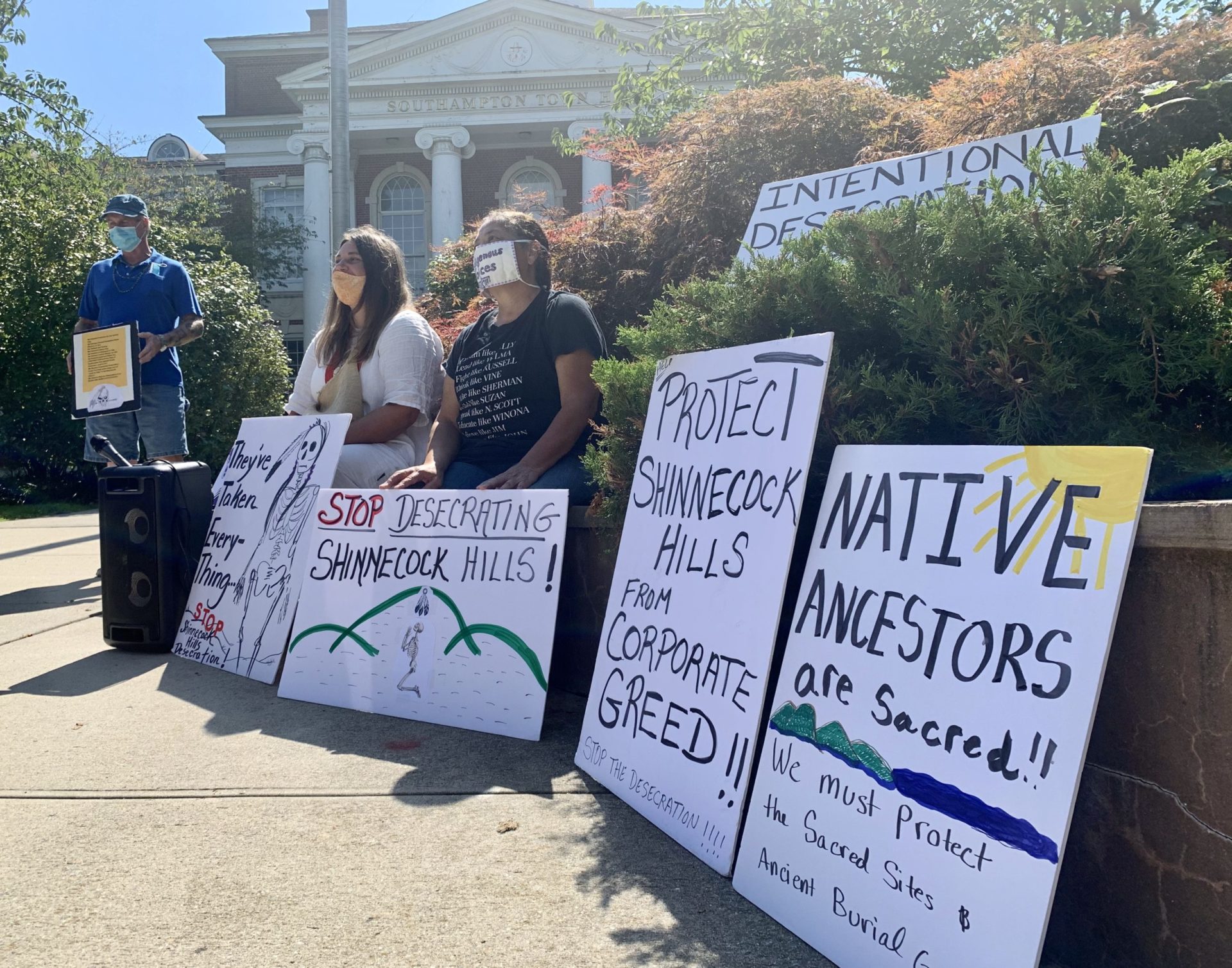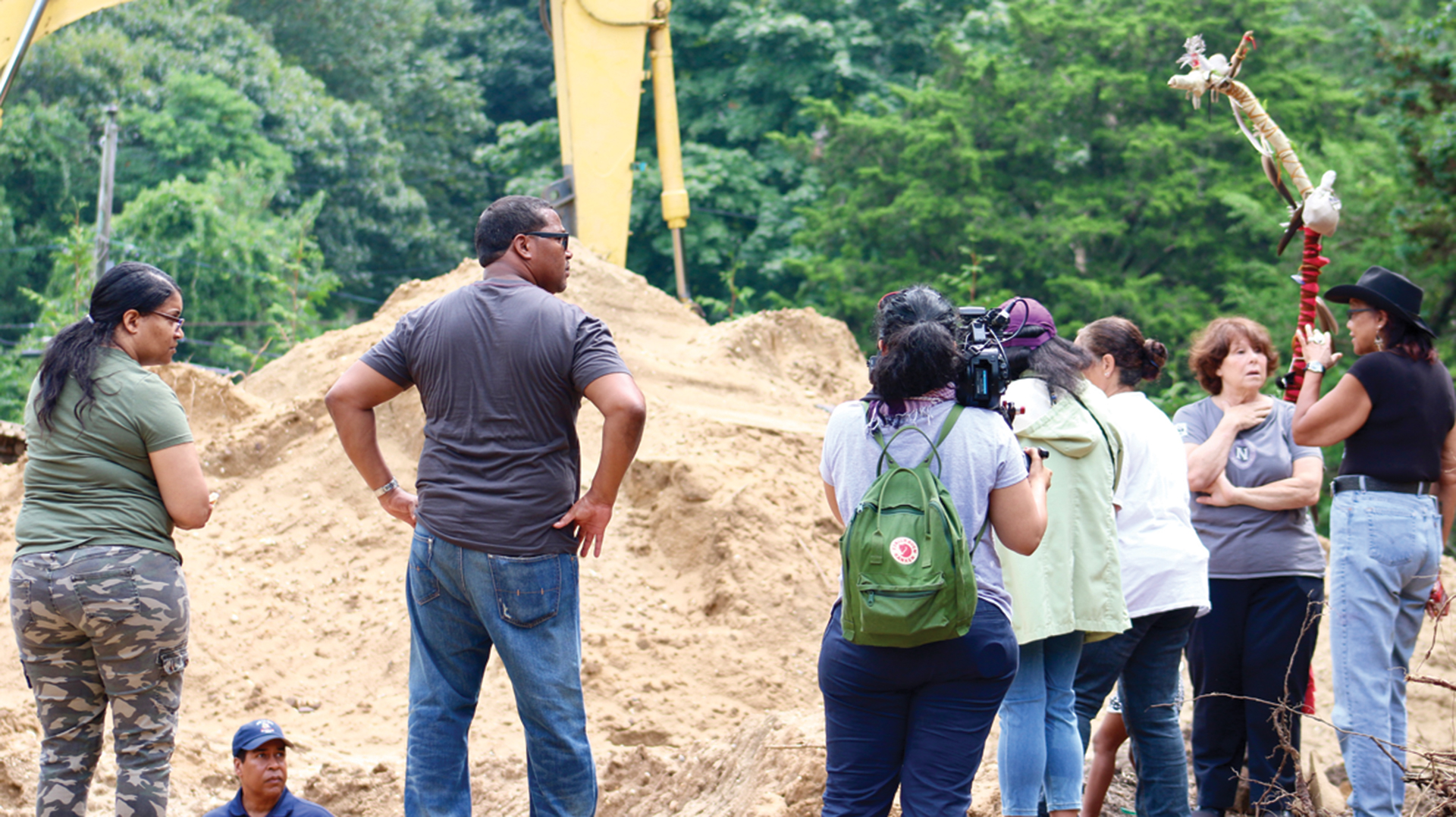Shinnecocks' Cry for Protection of Unmarked Graves Finally Answered


The Southampton Town Board passed historic legislation Tuesday afternoon to protect unmarked Shinnecock graves and burial sites, the first law of its kind in New York State.
“Protection for Unmarked Graves” establishes a set of protocols if human remains are encountered during construction activities anywhere in the township. Penalties for not complying with the law include a fine of at least $10,000.00 or 15 days in jail.
“We can’t erase 400 years of history. What we can do is move froward with some positive steps to respect the people who were here first,” Supervisor Jay Schneiderman said after the board ratified the law, often referred to as Graves Protection, and then proceeded to enact a six-month building moratorium on building in areas of Shinnecock Hills, the Shinnecock Indian Nation’s ancient sacred burial grounds.
Shinnecocks have long sought to stop building in the Fort Hill and Sugar Loaf areas, as well as other locations where they believe their ancestors are buried. After several failed attempts at the state legislature to pass protection for unmarked graves, Schneiderman took up the issue at Town Hall. He said it became apparent how necessary the law was after human remains were unearthed on a Hawthorne Road construction site in 2018 and there was nothing the town could do to stop work.
New York State is one of only four states that lack any kind of graves protection law.
“The Shinnecock have been saying for years, we need procedures, we need something on the books,” Schendierman said. “This has been a cry for decades, decades.”
While the town was able to purchase the Hawthorne Road property with money from the Community Preservation Fund, other properties came into question that could not be saved. Schneiderman introduced the graves protection bill and the moratorium in February and scheduled a public hearing for March — “then boom, the pandemic swept across the globe,” he said.

Many grew frustrated when, month after month, the hearings were adjourned, while building projects moved forward. A protest was held last month, which led to a confrontation between Schneiderman and members of the Shinnecocks’ Graves Protection Warrior Society, like Rebecca Genia and Jennifer E. Cuffee-Wilson, who have been fighting for decades to stop grave desecration. Genia — whose activism was a focus of the documentary film, “Conscience Point,” — sat in front of Town Hall again on Tuesday to rally support.
Genia refused to attend the meeting, but sat outside surrounded by handmade signs, such as “Protect Shinnecock Hills from corporate greed!!,” and “Native ancestors are sacred!!”
But, Cuffee-Wilson went to the podium to make one last plea. “We have been dealing with this for close 30 years. This is not anything new. It should not be new to you, okay? You just happen to be the fourth supervisor and the fourth board we have dealt with, okay? We have been dealing with such disrespect since 1640,” she said. “We have been good neighbors. We taught ancestors how to survive. We taught your ancestors how to live. We gave you land. What did we get in return? You stole it from us. You lied to us. You cheated us. And the worst thing about it was you dug up our ancestors. You put them in museums or you threw them away. And it’s still happening today.”
Bryan Polite, the chairman of the Shinnecock Tribal Council, said their anger is not directed at anyone person, but rather at the system, which has continually let them down.
“Since 1640 the relationship between the Town of Southampton and the Shinnecock Nation has been marred with past injustices, land theft, and broken promises, but today marks a new brighter chapter in the 380-year relationship between the Town of Southampton and the Shinnecock Nation,” Polite said.
He thanked the Warrior Society’s hard work and dedication, especially Genia, “for unwavering in her fight to protect the grave sites of our ancestors,” he said, adding, “I would also like to thank the Southampton community who supported, marched with, and stood side by side with the Shinnecock Nation; your efforts are greatly appreciated.”
The moratorium gives the board six months “to figure out what laws ought to be on the books to protect Shinnecock graves, potential colonial graves, artifacts that once destroyed we’ll never be able to learn from history again,” Schneiderman said. The goal is to adopt local legislation “to ensure that human remains and associated funerary artifacts remain undisturbed to the maximum extent practical, and are treated with the utmost respect consistent with the wishes of lineal descendants and culturally-affiliated groups,” a town press release said.
The moratorium also affects other large-scale excavation projects in the areas such as accessory structures and swimming pools.
Properties under the moratorium are located north of Montauk Highway, which includes the Shinnecock Indian Contact Period Village Fort region, and those parcels located south of Montauk Highway, which includes the Sugar Loaf Hill Shinnecock Indian Burial Ground region.
Those who wish to start a building project during the moratorium must complete and show proof of a field study in the area proposed to be excavated, dug, or graded showing no buried artifacts, graves, or grave objects were found. They must use subsurface ground-penetrating radar at a depth of at least eight feet.



